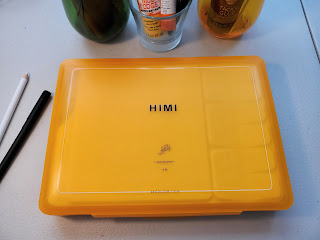Although the houndstooth pattern looks extremely intricate, it is formed of very basic geometric shapes – squares and stripes – and can be fun to doodle, once you get the hang of it. Many people find doodling relaxing and meditative, and some people find that doodling helps them concentrate. If you like to doodle or draw intricate or repetitive patterns, you may find learning to draw the houndstooth pattern to be very enjoyable. I have broken it down into very easy, illustrated steps so that you can easily learn to draw houndstooth right away!
1. Draw a light grid or use graph paper. Draw and fill in every other square in a row, skip a row, then repeat.
3. Draw smaller lines on each side, so that those squares are divided into four parts. The little squares that are left with no lines are your white squares (or whatever color the paper is). As you draw, you will see that they will follow the same type of pattern as the black squares – there will be a white block every other square, with a striped square on each of its four sides, on the alternating rows. This is what will create the houndstooth pattern.
4. Here's the tricky part. These squares are going to be striped in alternating black and white. That's clear enough. But, when going across, the stripey squares between the solid black squares all "start" with black in the lower left corner, and the next row down - where the stripey ones alternate with the solid white squares, the pattern is reversed, and the lower left corner is white.
The easiest way for me to remember what goes where is to see this pattern as a "bunny in a bow tie". Both sides of his little bow tie need to be the same color.
5. Continue as desired
You may find it easier to draw the pattern larger, especially if you would like to keep the smaller stripes more uniform and precise. This could also be easier if you are just starting to learn how to draw the houndstooth pattern, or if it is difficult to see or to draw the pattern at a smaller size.
Beneath the smaller houndstooth pattern on the graph paper below is a reference for houndstooth using a 2x2 pattern (each block is 2 across and 2 down, for a total of four graph squares in each block of solid or stripe). I left it partially unfinished so you can see how it is easier to draw the smaller connecting lines of the stripe sections in the houndstooth pattern.
I hope you have enjoyed this tutorial! Join me on my Facebook page for more shenanigans!
Cover image: https://en.wikipedia.org/wiki/Houndstooth#/media/File:Houndstooth.jpg
Step-by-step images, my originals (see copyright notice)


















































